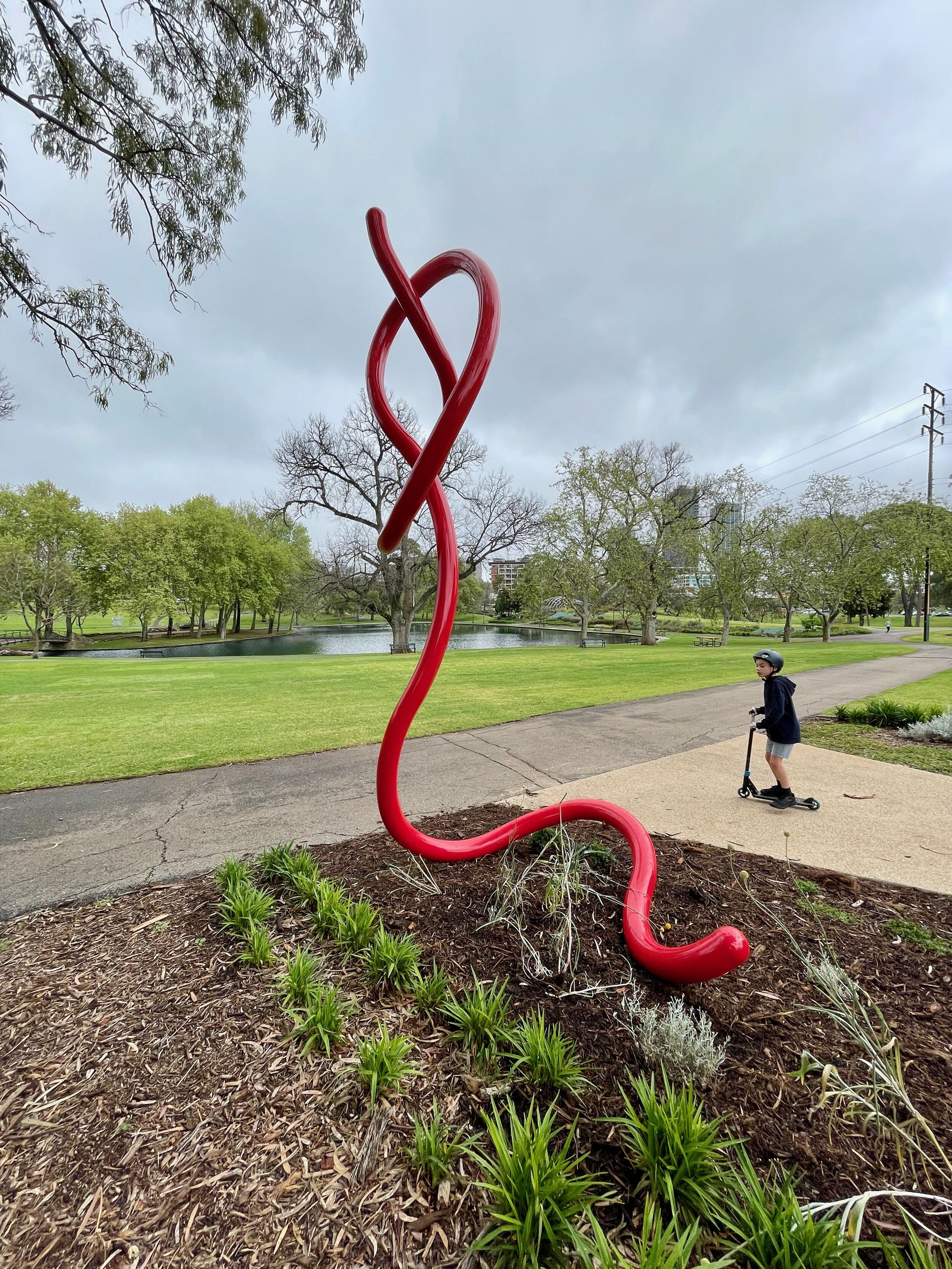by Carla Caruso
A bright red, steel sculpture sits at the entrance of the Quentin Kenihan Inclusive Playspace, enticing kids of all abilities to come in and play.
Although, they’ll have to wait for the moment while the playspace in Rymill Park / Murlawirrapurka (Park 14) undergoes an upgrade.
Adelaide City Council is spending up to $500,000 to make the accessible playground, honouring disability advocate Quentin Kenihan, actually comply with the Disability Discrimination Act.
‘sQuiggle’ is said to embody Quentin Kenihan’s essence. Photo: James Elsby.
The council’s busy this month installing shade sails, extending the rubberised ‘superloop’ track, increasing signage, and adding soft fall.
The entire upgrade isn’t expected to be complete until after a second round of upgrades in January.
But for now, the 4.3m-high sculpture at the entrance offers something for children to interact with.
It was installed in May 2021 – after the playspace was built the year before – and is the design of Adelaide artist Karl Meyer.
The piece, named sQuiggle, took about 450 hours to create, from concept to installation.
Adelaide sculptor Karl Meyer is behind the design.
Karl says it encapsulates Quentin’s “essence”. Quentin was born with a brittle bone disease called osteogenesis imperfecta. He died in 2018 while working with the council’s administration on plans for such a playground in the Park Lands.
For research, Karl read Quentin’s biography and spoke with his family and friends.
“It’s one of those stories of a man, who was inevitably always challenged by his body and his limitations, but always managed to find ways through,” Karl says.
“A public profile like that – you don’t realise someone hugs him, and suddenly, a rib’s broken just because he was that fragile.
“[But] he’d actually have empathy because somebody would move him or do something and he’d just be like, ‘Ah, right, that’s just caused me pain for the next X number of weeks, because you weren’t aware, and why would you be?’”
Karl says Quentin’s life had “ups and down and twists and turns”, much like the sculpture, yet was aspirational.
Inside the inclusive playspace before the upgrade began. Photo: James Elsby.
“[Starring in] Mad Max [Fury Road] was an apex of what Quentin was trying to achieve. He wanted to be a filmmaker and he wanted to do comedy and he wanted to be in major films.
“There’s that aspiration as a personality of how far he was willing to take himself. He was able to push through those barriers that were considered limitations.”
Karl says the ‘superman’ red of the sculpture represents Quentin’s “enthusiasm for superheroes and his fondness of Christmastime”. The hue also offers a contrast with the surrounding greenery.
Quentin Kenihan was a fan of superheroes. Photo: Perth Now.
“Visually, the form provides subtle gestures to The Knot by Bert Flugelman [in Light Square / Wauwi], oblique upper- and lower-case Qs, and crazy straws.”
Elsewhere in the city, many would recognise Karl’s series-of-circles sculpture at the entrance to the Adelaide Zoo in Park 11. It’s dubbed Camouflage.
“That was really playing with the notion that if animals use camouflage as a technique, they’ll devolve back into the urban landscape,” Karl says.
“So, give it several million years, there will be animals that look like street furniture. You don’t need stripes anymore when you’re in an urban environment.”
‘Camouflage’ is an earlier work by Karl Meyer, outside the Adelaide Zoo - part of the Adelaide Bike Art Trail. Photo: Experience Adelaide.









